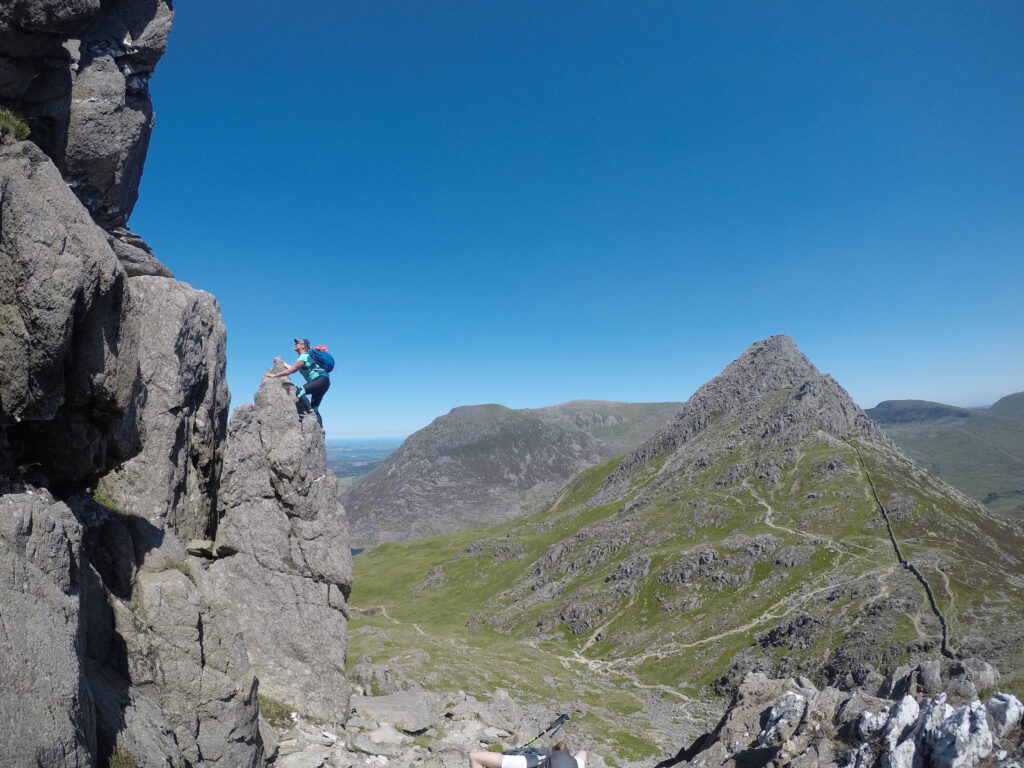
Holly on Everest summit. Photo: © How Many Elephants.
Holly Everybody knows there’s lots of bodies, but until I actually had to step over several of those bodies on the way up to the summit, nothing really prepared me for that.
********
To put it in perspective, 35,000 elephants are poached each year in Africa, and there’s just under 400,000 elephants left.
********
Peter Welcome to our travel podcast. This week, we’re talking to someone whose passion for action-packed adventures has taken her to the summit of Everest and the savanna of Africa. Skydiving, mountaineering and saving elephants may seem like strange bedfellows, but not for Holly Budge. Holly, welcome to our travel podcast. Now you’re recognised as one of the leading female adventurers in the UK, with a passion for adrenaline sports and for saving elephants. Sixty seconds of what you’ve described as sheer terror transformed your life. Where were they, and why did they?
Holly Those 60 seconds were in New Zealand when I first threw myself out of a perfectly good airplane. And those 60 seconds of sheer terror completely changed the course of my life. Not only did I love the feeling of jumping out of a plane – I wanted to go straight back up and do it again – but I was also blown away that people were actually getting paid to jump out of perfectly good airplanes every day of the year. And this was something I decided there and then that I wanted to do. So it was quite a far-fetched goal: I didn’t know anyone in New Zealand, I knew nothing about skydiving and I knew nothing about filming.
Peter How old were you then?
Holly Twenty-one.
Peter It was a very important change of direction. What had you been doing before then?
Holly I was working as a graphic designer in London, so I went back to London, carried on working, saved up enough money to buy a ticket back to New Zealand, put myself through my skydiving course and several months later I got my dream job and was getting paid to jump out of airplanes up to 12 times a day, every day. And it only took three skydives to pay for my month’s rent, so I’ve never been so as rich as I was at 21. But I guess the important thing for me, looking back, is I refer to this as the boldness of youth – because I didn’t overthink it. I just gave everything I had. And when I achieved my dream job, this gave me a huge self-confidence and belief that I could do whatever I put my mind to, or I could at least have a go. And that’s taken me on some pretty amazing adventures.
So I guess it’s about holding on to that…for me, it’s about holding onto that 21-year-old mind set. And I’m now 41, so I’ve tried to put that into practice for two decades.
Felice It did it all start? Were there any influences in your childhood – going on adventures?
Holly I think I was pretty adventurous from an early age. I grew up competing into triathlons. I went right up to compete for my country in equestrian, in show jumping and eventing. I did tetrathlons, which was running, swimming, shooting and riding. And I think what it taught me very early on was…it kind of toughened me up and taught me the importance of teamwork. And if you fall off the horse, you dust yourself down, you get straight back on.
I was always in the outdoors. I feel so fortunate to have had the childhood I had, compared to what it might have looked like today with technology. So I was never really watching TV, and obviously we didn’t really have mobile phones back then at all, not as we know them today anyway. So, yes, I was always outdoors and I think for me I was very fortunate because my parents have always supported my decisions on an emotional level.
When I came home and said: ‘I’m going to move to New Zealand and become a skydiver,’ they said: ‘Brilliant. Go for it.’ Whereas I’m sure a lot of parents would have had a fit if their 21-year-old daughter was moving halfway round the world to jump out of aeroplanes. So I think that’s been really important having that support from my family as well.
Peter So what happened then? Everest then loomed into your sights, or was that later?

Holly in the plane just before Everest jump. Photo: © How Many Elephants.
Holly So then I heard about this world first expedition to skydive Mt Everest. So as a skydiver, I just knew that was an opportunity I didn’t want to miss out on. So I rang up the organiser and it quickly became apparent there were no other females booked onto that trip. So I knew that was my hook for getting sponsors on board: to become the first woman to skydive Everest. So they said to me on the phone: ‘Can we count you in?’ And I said: ‘Yes, absolutely.’ And they said: ‘That will be £24,000.’ And I said: ‘Yes no problem. Count me in.’ I didn’t have £24,000 just sitting there, but I knew that I would give it everything I had to go and find some sponsors, and that’s exactly what happened.
I went on to become the first woman to skydive Everest. We jumped out of a small aeroplane at 29,500 feet and the aeroplane had never actually flown to that altitude before. So that was also a world first. And then I actually fell out of the plane. Nothing could have prepared me for that. The door opened; I’m giving my count: ‘Ready set…’ And the next thing I have my cameraman’s hand pushing my shoulder back, pushing me back into the plane. And the pilot held a Stop sign saying: ‘Don’t let the jumpers out.’ But I had too much momentum on my ready set go, and I was back-pedalling in the door and I actually fell out of the plane.
So I think one of your questions was, is skydiving Mt. Everest terrifying? And in that instance: absolutely. But luckily I made it back to the landing area and had a safe landing. And then the clouds rolled in and it was a complete whiteout, and I felt extremely fortunate to have walked away safely from that jump.
Peter So you jumped out at the same height as Everest? At 29,000 feet? What height did you land?
Holly I pulled my parachute 18,000 feet and I landed at 12,500 feet, which was the highest civilian landing area at that time. Maybe it still is. So to put that in perspective, when I was skydiving in New Zealand, I would be jumping out of an aeroplane at 12,000 feet and here I was landing at that altitude. So my parachute was three times the size of my normal chute to make up for the the higher altitude, thinner air. Yes, so it was quite different than any skydive I’d done before, that was for sure.
Felice I mean, I’ve never skydived, so can you tell me what the feeling is?
Holly Skydiving, certainly when you first experience it, is a total assault on all of your senses. Every part of your body is thinking that’s not a natural thing to do. You know, I remember when I first skydived, watching people in the aeroplane that were working as tandem masters and cameramen, which is what I went on to be…they were so relaxed and they were chatting and laughing. And I just thought: ‘How can anyone be this relaxed when you’re about to jump out of a plane?’ So when you’re doing it 12 times a day every day, it does become quite normal.
I used to say to people that my heart rate didn’t change, particularly, when you’re doing it all day, every day. It was a bit like getting up and cleaning your teeth, which is both a good and a bad thing. It’s good because you can train your mind to get comfortable with the uncomfortable, but it’s bad in that you shouldn’t ever be get too comfortable or blousy with jumping out of an airplane because it definitely can come back to bite you.
Peter Have you ever had a parachute malfunction?
Holly I’ve only had to pull my reserve chute once in 3,500 jumps, which is always a good thing.
Peter And that was OK? You landed OK?
Holly Back then we didn’t have a GoPro like you get today. We had digital SLR on the top of our head and a video camera on the side. So the camera helmet weighed probably around four kilos, which is crazy when you think now what a teeny weeny little GoPro would weigh. So one of my lines got caught on my helmet and my head was totally pinned forward and then I started spinning. So that’s when I knew I had to cut away the main parachute and then pull my reserve. It was OK, but I’ve had other experiences skydiving – I’ve fractured my neck from a parachute opening too hard, but that wasn’t anything to do with the reserve being pulled. That was just the main parachute that did that. Like I said, it can bite you in the bum sometimes, skydiving.

World’s first skydive from Everest. Photo: © How Many Elephants.
Peter So when you landed from Everest, you then did something quite extraordinary. You decided to go and climb it.
Holly Yes. There were several years in between that; there was nine years between those two events. But when I first laid eyes on Mt Everest, I knew one day I would be back to climb it to the top, but I knew nothing about mountaineering. So I set about learning how to mountaineer, and I quickly found myself back in the Himalayas, climbing other big mountains. So when I turned up to climb Everest, I’m very pleased to tell you that I had the right skill sets, I had experience in the mountains. And the reason I say that is I met people on Everest that never stepped foot on snow before, trying to climb to the summit. My advice to anyone is if you want to climb Everest, go and climb some smaller mountains first, and gradually work your way up and see how your body fares at altitude, because for some people, they just simply can’t deal with the altitude.
Felice So where did you go to learn how to do this?
Holly In the Himalayas. Yes, so I climbed Mera Peak, a 6500-metre peak, and I thought it would be a really good idea to snowboard back down from the summit. Quite frankly, not one of my best ideas, not a chair-lift or a restaurant in sight on those mountains. It was it was a silly thing to do. Great big open crevasses and not good conditions. Great view of Mount Everest in the background.
And then I went on to climb Baruntse, which is 7000 metres. And that’s, I think, one of the most remote mountains in the Himalayas. And they actually call that Death Valley, because if the weather comes in, then the helicopters can’t come in to do any rescues. So you really are sort of stuck in this valley and you have two 6500-metre passes that you have to go to get out of this valley – each side. So it’s quite committing, that one. And then I did my first 8000-metre peak, Cho Oyu. I mean, any climbing above 8000 metres is is tough. You know, you kind of get your confidence up and think: ‘I’m feeling good’ at 7000 meters and then you go on to an 8000-metre peak, and that last 1,000 meters and upwards…you really do notice that last bit is a difficult place to be. Difficult environment to be in.

I climbed Everest as a two-man team, which is quite rare. So I’d worked in the Himalayas, I’d led a few expeditions by this point, and the Sherpas that I’d worked with previously, I was climbing Everest with one of those Sherpas, but on a very equal footing. My bag was as heavy as theirs; carrying my own equipment. So what that meant was being a small team, we were agile, we could make decisions quickly.
One of the reasons I climbed Everest on the north side was to avoid the queues. Everest on the north side is much colder and there’s no rescue. The Chinese won’t let any helicopters into the air space. So you really do pretty much have to walk yourself back off that mountain; you can’t rely on any external help. So me and my climbing partner, Jangbu Sherpa, we found ourselves in a queue on our summit push. So that wasn’t really part of what we wanted, so we opted to stay an extra seven hours in the high camp before going to the summit to allow the two teams in front of us to go first.
So there was a team from China and a team from India. And what that meant was we still had to sit and wait for about three hours while they were coming back down. There was this one little bottlenecked area. We didn’t get to the summit until 1.30pm in the day, which is late, but we had planned to do that. And what that meant for us was we got to sit on the summit of Mount Everest for half an hour with just the two of us, which is an incredibly rare thing. And we had a beautiful blue sky, an amazing view.
But we weren’t so lucky on the descent, a storm came rolling in quickly and we had to spend the night at 8300 meters at the high camp. So a pretty uncomfortable night, we would have been the two highest living people on Earth at that point. Certainly on the north side, we were the only two in the campsite and these winds got more and more ferocious. And I remember lying in our little yellow tent thinking the sides were going to be ripped off at any moment. And then I started thinking, if we became airborne, I would know what that feeling felt like if we were suddenly in freefall, but I would know that I didn’t have a parachute on my back, I’d just be inside of this yellow tent.
When we looked out in the morning, we were one of only three tents left standing. Everything else had been blown away. And the guys that we were chatting to at Camp Two, so the campsite beneath us, some of them actually had their tents ripped off when they were in the tent. So the ground sheet was left on the ground with them on it, and the rest have been ripped off. That just gives you an idea of how ferocious that storm was. And it didn’t relent in the morning – we knew we had to get off this mountain and fast. And we still have a long way to go from the high camp back to the safety of advanced base camp. And it took us nine hours to get back down. So that was a pretty difficult day, at times we couldn’t even stand up, you couldn’t even crawl. You just had to lie flat on the ground, the winds were so strong. So, yeah, it was pretty intense. But we did feel good that we had a good and responsible summit on Everest.

Holly on the summit of Cho Oyu. Photo: © How Many Elephants.
I know we all hear about the bodies on Everest, everybody knows there’s lots of bodies. But until you actually, well for me, until I actually had to step over one of those or several of those bodies on the way up to the summit, nothing really prepared me for that. One of the first bodies I saw was an Australian guy who had died the day before. And he was just outside of that high camp where we had to spend the night. So it was in my mind all night that as soon as we left that camp, we’d have to step back over this body. And it really does bring it home to you how fine the line is between life and death when you are up at those altitudes.
But I often get asked, didn’t you feel like turning around when you saw the first body? And to me, absolutely not, because I totally backed myself that I had the right skills and the knowledge that I needed to be there to get the job done. If I’d started feeling sick or ill myself, or I’d had an accident or anything like that, was able to walk, I would have turned around for sure. But I think that’s what it’s all about, is knowing your own capabilities and being responsible.
Peter And having self-belief and no negative thoughts?
Holly That’s it, yes, but being realistic definitely is a good one.
Peter You have an interesting climbing technique, I was reading about, of following the footstep in front. And then reversing the role when your climbing partner’s behind you. Can you tell us about them?
Holly Yes, so I’ve sort of accidentally pioneered a technique called the Shadow Step, which is my name for it. And quite funny how it came about. The first two mountains I climbed, I reached the summit way before the rest of the team on both of these mountains, and they were my first two mountains in the Himalayas. And people were saying, you know, guys in the team, were saying, you know, how how did you just do that? How is that happening? And at the time, I wasn’t really sure. But now I absolutely know what it was and it’s a technique that I employ on every mountain.
So when you leave high camp, it’s dark, it’s freezing cold, there’s nothing to see. So you put your head torch on, and on those first two mountains I just slipped in behind the Sherpa. And when the Sherpa moved his foot, I moved mine, when he moved his foot, I move mine. Sounds very simple, but what that does – and now I know what that does, but at the time I was just just doing that – is it keeps your mind quiet and focussed. So if you get behind the team, especially when you’re at high altitude and it’s freezing cold and it’s pitch dark and you’re quite scared, you might feel scared you’re not going to catch them up and you’re going to be left alone and maybe you’ll be left to die there on your own. These kind of thoughts pop into your head. And once those negative voices do start to come – now with them, over the years, I’ve seen it once. Once they’ve set in, they’re very difficult to get rid of at high altitude.
So what this does is keep your mind occupied, it’s a very simple technique, but it absolutely works. And I’ve tried it now with running, with hiking. So the next time you’re walking up a really big hill and you’re thinking this is really hard work and I don’t want to go any further, just get behind the person in front and literally focus on their feet and following their feet. And it is phenomenal. It totally works. Now I’m less selfish about it and I rotate around with whoever I’m climbing with, so they’ll follow me for a bit. I’ll follow them. But that is literally how I now climb mountains.

Hwange National Park, Zimbabwe. Photo: © How Many Elephants.
Felice Moving from Everest to elephants, can you tell us a bit about that?
Holly Yes, absolutely. So as much as I love doing adventures, I felt I wasn’t really using the creative side of my brain as much as I wanted. So I went back to my roots, which is design, and I went and studied for a Masters in Sustainable Design seven years ago at the University of Brighton. And that, again, was a pretty big game changer for me, completely expanded my mind and it was the most brilliant two years; I loved it.
So I went there to study a material called vegetable ivory, which is a nut from a palm tree from South America. It’s an incredible material in its own right. But its material similarity to elephant ivory that got me researching the African elephant crisis. And I was so horrified at the statistics that I was reading that I wanted to come up with a really fresh approach to raise awareness of this crisis. So I came up with this exhibition that showcases 35,000 elephants on a wall, and that’s the annual poaching rate currently in Africa.
And then I also built this necklace, which is 96 elephants – the daily poaching rate – cut in vegetable ivory. The original necklace has won five design awards so far. And I’ve weaved a narrative into it – one elephant was cut in brass because the poachers’ bullet shells are commonly made from brass, and one elephant was facing the other way to say that this crisis can still be turned around and the elephants aren’t extinct yet.

The necklace designed by Holly. Photo: © How Many Elephants.
But to put it in perspective, 35,000 elephants are poached each year in Africa, and there’s just under 400,000 elephants left in the wild. So it’s definitely something that is happening right now and requires our attention for sure. So I’m using design as a powerful communication tool to bridge the gap between scientific data and human connection. When you see and connect with 35,000 elephants on a wall, it’s really impactful.
I’ve had people come to my exhibitions which are happening around the world. Some people just burst into tears and said: ‘We just had no idea. We just didn’t know this was happening.’ That’s happened on a few occasions, most of which are people from China, the world’s largest ivory consumers. And quite a lot of them have just said it’s so deeply ingrained in their traditions and their beliefs they didn’t even question where the ivory was coming from. And I’ve also met people that think the tusks fall out and regrow.
So a stark reminder that greater education and awareness is needed. I’ve purposely avoided using anything gruesome. There’s nothing gruesome or gory in my campaign, and that’s worked fantastically to be able to connect with audiences of all ages. So I’ve gone into many schools, done lots of workshops, and the children then colour in their own elephants and have their own exhibitions at school. And I recently went to a school that had 168 elephant artworks on the wall, pre-Covid obviously, pre-lockdown. And when you tell the children this represents less than two days’ worth of poaching, their little faces drop. But it’s a great way to get that message across to them.
If I was showing mutilated pictures of elephants, I just wouldn’t get anywhere with that approach. So that’s the campaign. And then I raise funds through my adventures – I’ve raised four hundred thousand pounds to date. And so through my charity, I support Direct Action anti poaching initiatives in Africa and that’s really reshaped the way my adventures have now become, because my adventures are now hanging out with anti- poaching teams on the front line as opposed to chasing world firsts and world records.

Holly and the Black Mambas. Photo: © How Many Elephants.
Peter You have your own anti poaching team called The Black Mambas?
Holly No, no, that’s not my team; I can’t take credit for them but they are one of the initiatives that I work closely with and support. They were founded in 2013 by a guy called Craig Spencer. And these ladies are based in South Africa and they’re the first and only all-female anti-poaching team in South Africa. And they are just incredible women; I’ve spent quite a lot of time with them on the front line. They’re unarmed, they just have pepper spray and handcuffs. And that’s a very conscious decision that they’re not armed because I’ve also spent time with a team in Zimbabwe called Akashinga, and they all are fully armed, they all have AK 47s.
So it’s quite a difference, I’m not sure which one was more unnerving: being with an unarmed team or an armed team. With the Black Mambas, in their words, they’re the ‘bobbies on the beat’; they’re the eyes and the ears on the ground. The idea is they don’t come face-to-face with the poachers. They are the first line of defence and they’re trying to disrupt the landscape, so they do morning and night patrols – they’re always patrolling in different places so people can’t get used to their movements, and they check all the fence lines for incursions, they dismantle snares and they’re just generally monitoring the wildlife. To be honest, it’s working brilliantly because they haven’t seen an increase in poaching during Covid times.
So there’s been a big increase in many parts of Africa with the bush meat poaching. But these guys work very closely with the communities and it really is testament to the work that they’re doing on the ground that there hasn’t been a big spike. That’s not to say there won’t be, but certainly now they seem to be managing that really well, and they take food parcels into the communities and they really focus on the education and awareness. Hanging out with those ladies, it’s been an absolute privilege. Also spending time on the front line with Akashinga in Zimbabwe, and they are fully armed – so that went beyond an adventure, that was like being in the middle of a war zone.

Holly with the Ashinga. Photo: © How Many Elephants.
We were out in a very remote part of the bush, and it was just me and these ladies. And it’s pitch dark, there’s signs of poachers, there’s wild animals, and it really does bring it home to you that these women are your lifeline…very much so. So that’s been my most recent adventure.
Going forward, I’m planning on hiking the Great Wall of China, not necessarily just for the adventure, but as a sort of central point for carrying out research into how does elephant ivory fit into their culture and into their deep-rooted traditions and beliefs. That’s obviously being put on hold for now, but certainly that’s still on the cards at some point.
Peter And that’s a long walk.
Holly That is a really long walk. I’m trying to do that with the Sherpa that I climbed Everest with. I think you need to go with someone that you get on extremely well with and can have long periods of time where you don’t need to chat. And, you know, you’re just happy and comfortable in each other’s company and in each other’s ability. So I thought that would be a perfect hike to have Jangbu Sherpa on that one, yes, absolutely.
Felice Yes, I’ve been to a bit of the Great Wall of China near Beijing and that was really crowded.
Holly Oh, I bet.
Felice We had to queue to go on to it.
Holly Yes, it’s only a very small percentage of the wall is open to tourists. So I’m really pleased that for the most part of that hike, would not be in those crowded conditions. Otherwise I wouldn’t even entertain it, because I’ve heard it gets pretty busy.
Felice In order to get your message across you’re doing quite a lot of public speaking. Is this something you taught yourself?
Holly I think I’m self-taught – I’ve been doing it for so many years, I forget now. I’ve definitely had help along the way for sure. But that’s what pays my bills: Keynote speaking, I don’t make any money out of the the charity, and I don’t want to. I have to say that the speaking has been amazing because it allows me to get paid and it’s also me spreading the word of the work that I’m doing and and the charity. And a percentage of that goes back into the charity as well. But I love it, it’s kind of what I call everyday adrenalin. So getting on a stage in front of 500 or 1,000 people is kind of on a normal life par with jumping out of an aeroplane or something like that.

Holly climbing. Photo: © How Many Elephants.
Felice So Holly, when you’re not raising money for elephants or skydiving or mountaineering, what do you do to relax?
Holly Yes, I do quite a bit of cycling. I’ve recently learnt how to kayak, so I just did the coast-to-coast race from one side of New Zealand to the other. I’ve been living out in New Zealand for the last year and a half, so I needed a new challenge because I was living in a very remote area. It was four-hour round trip to go to the supermarket, an absolutely stunning spot in the Southern Alps. So I was out every day training, running, road cycling and kayaking.
So I definitely enjoy trying out new things. But yeah, I don’t have a huge amount of spare time, but very much like getting out my bike or doing yoga, or doing any exercise and being in the outdoors. For me, I just love it.
Peter And you mentioned you’re a snowboarder?
Holly Yup, I’ve done quite a lot of snowboarding. I’ve done a couple of seasons out in Colorado. And I think when you work on your laptop, you know, people call it a digital nomad these days. But I mean, I’ve been doing that for years and years and years. So it’s amazing to be able to go to different places, but carry on with your work. You know, it just gives you so much freedom if you know that your office is your laptop.

Holly inspiring young minds. Photo: © How Many Elephants.
Felice How has your journey shaped who you are today?
Holly I think just the journey itself has shaped who I am in terms of going back to the 21-year-old mind set, just having a really positive mind set and just trying to…even when bad things happen, just trying to find a silver lining in that has really helped. Just following my passions…passion’s contagious, people buy into passion. And if you can get people to buy into your passion, then the world’s your oyster and that’s exactly how I’ve been able to fund doing all of these adventures. Yes, I think I’m just a very positive person. My motto in life is ‘think big, dream bigger.’ And I think if you can dream it, you can certainly have a go at trying to achieve it.
Peter Holly, in such an action packed life. Is the time a room for a partner? Or do you live alone?
Holly No, I’m married to a New Zealander and he’s a helicopter pilot, so he kind of does his thing and I do mine, and occasionally we see each other. My dad thinks that’s the perfect marriage.
Felice So if people want to know more about your charity, can you tell us what the website is?
Holly Yes, absolutely. So HowManyElephants.org is my website charity and HollyBudge.com is my adventure/keynote speaking website. And there’s lots of different ways that you can get involved with the charity, and that’s all on the website. We’ve just launched a volunteer programme as well, and I’m absolutely bowled over by the amount of people that have come forward with skills and passion, and just: ‘How can we help? How can we get involved?’
If you’re listening to this and would like to get involved, absolutely get in touch and we’d be delighted to hear from you. Every experience I’ve had with elephants has been totally magical. For me, that feeling of being out in the African bush and seeing the elephants in the wild is just like no other. Still, I get butterflies in my stomach when I see that, it’s a wonderful sight, and a sight that, of course, I hope we can keep seeing. The African savanna devoid of elephants would be truly heart-breaking.
Peter Holly Budge, thanks for coming on our travel podcast and we wish you the very best of luck with your charity How Many Elephants, and your future action-packed adventures, wherever they may be.
Holly Thank you very much. It’s been a pleasure chatting with you guys today.
Felice That’s all for now. If you’ve enjoyed the show, please share this episode with at least one other person! Do also subscribe on Spotify, i-Tunes, Stitcher, or any of the many podcast providers – where you can give us a rating. You can also find us on Twitter, Facebook and Instagram. Stay safe and we’ll see you next week.
Also see our podcast and post: On Safari With Alice In Africa.
© ActionPacked Travel
For other action women, see (or listen) to our episodes on A Solo Hiking Adventure, Matilda Temperley: Action Woman Behind the Lens, and Action Woman at Action Packed Travel.

- Join over a hundred thousand podcasters already using Buzzsprout to get their message out to the world.
- Following the link lets Buzzsprout know we sent you, gets you a $20 Amazon gift card if you sign up for a paid plan, and helps support our show.


